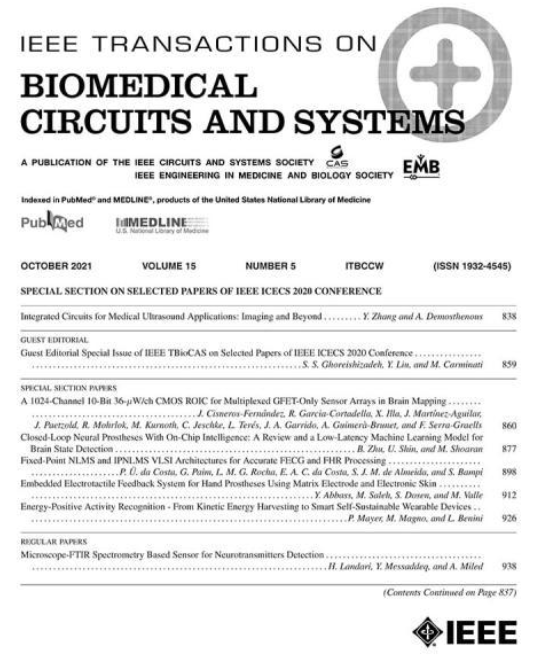A Wireless IC for Wide-Range Neurochemical Monitoring Using Amperometry and Fast-Scan Cyclic Voltammetry
IF 4.9
2区 医学
Q2 ENGINEERING, BIOMEDICAL
IEEE Transactions on Biomedical Circuits and Systems
Pub Date : 2007-05-27
DOI:10.1109/ISCAS.2007.378094
引用次数: 13
Abstract
An integrated circuit for real-time wireless monitoring of neurochemical activity in the nervous system is described. The chip is capable of conducting measurements in both fast-scan cyclic voltammetry (FSCV) and amperometry modes for a wide input current range. The chip architecture employs a second-order DeltaSigma modulator (DeltaSigmaM) and a frequency-shift-keyed transmitter operating near 433 MHz. It is fabricated using the AMI 0.5-mum double-poly triple-metal n-well CMOS process, and requires only one off-chip component for operation. A measured current resolution of 12 pA at a sampling rate of 100 Hz and 132 pA at a sampling rate of 10 kHz is achieved in amperometry and 300-V/s FSCV modes, respectively, for any input current in the range of plusmn430 nA. The modulator core and the transmitter draw 22 and 400 muA from a 2.6-V power supply, respectively. The chip has been externally interfaced with a carbon-fiber microelectrode implanted acutely in the caudate-putamen of an anesthetized rat, and, for the first time, extracellular levels of dopamine elicited by electrical stimulation of the medial forebrain bundle have been successfully recorded wirelessly using 300-V/s FSCV.应用安培法和快速扫描循环伏安法进行大范围神经化学监测的无线集成电路
描述了一种用于实时无线监测神经系统中神经化学活动的集成电路。该芯片能够在宽输入电流范围内进行快速扫描循环伏安法(FSCV)和安培法模式的测量。该芯片架构采用二阶DeltaSigma调制器(DeltaSigma)和频率移位键控发射机,工作频率接近433 MHz。它采用AMI 0.5 μ m双聚三金属n阱CMOS工艺制造,只需要一个片外组件即可运行。在安培测量和300 v /s FSCV模式下,在100hz采样率下的测量电流分辨率为12pa,在10khz采样率下的测量电流分辨率为132pa,在±430na范围内的任何输入电流。调制器核心和发射机分别从2.6 v电源中汲取22mua和400mua。该芯片的外部与一个碳纤维微电极连接,该电极被急性植入麻醉大鼠的尾壳核,并且首次成功地使用300 v /s的FSCV无线记录了由电刺激内侧前脑束引起的细胞外多巴胺水平。
本文章由计算机程序翻译,如有差异,请以英文原文为准。
求助全文
约1分钟内获得全文
求助全文
来源期刊

IEEE Transactions on Biomedical Circuits and Systems
工程技术-工程:电子与电气
CiteScore
10.00
自引率
13.70%
发文量
174
审稿时长
3 months
期刊介绍:
The IEEE Transactions on Biomedical Circuits and Systems addresses areas at the crossroads of Circuits and Systems and Life Sciences. The main emphasis is on microelectronic issues in a wide range of applications found in life sciences, physical sciences and engineering. The primary goal of the journal is to bridge the unique scientific and technical activities of the Circuits and Systems Society to a wide variety of related areas such as: • Bioelectronics • Implantable and wearable electronics like cochlear and retinal prosthesis, motor control, etc. • Biotechnology sensor circuits, integrated systems, and networks • Micropower imaging technology • BioMEMS • Lab-on-chip Bio-nanotechnology • Organic Semiconductors • Biomedical Engineering • Genomics and Proteomics • Neuromorphic Engineering • Smart sensors • Low power micro- and nanoelectronics • Mixed-mode system-on-chip • Wireless technology • Gene circuits and molecular circuits • System biology • Brain science and engineering: such as neuro-informatics, neural prosthesis, cognitive engineering, brain computer interface • Healthcare: information technology for biomedical, epidemiology, and other related life science applications. General, theoretical, and application-oriented papers in the abovementioned technical areas with a Circuits and Systems perspective are encouraged to publish in TBioCAS. Of special interest are biomedical-oriented papers with a Circuits and Systems angle.
 求助内容:
求助内容: 应助结果提醒方式:
应助结果提醒方式:


